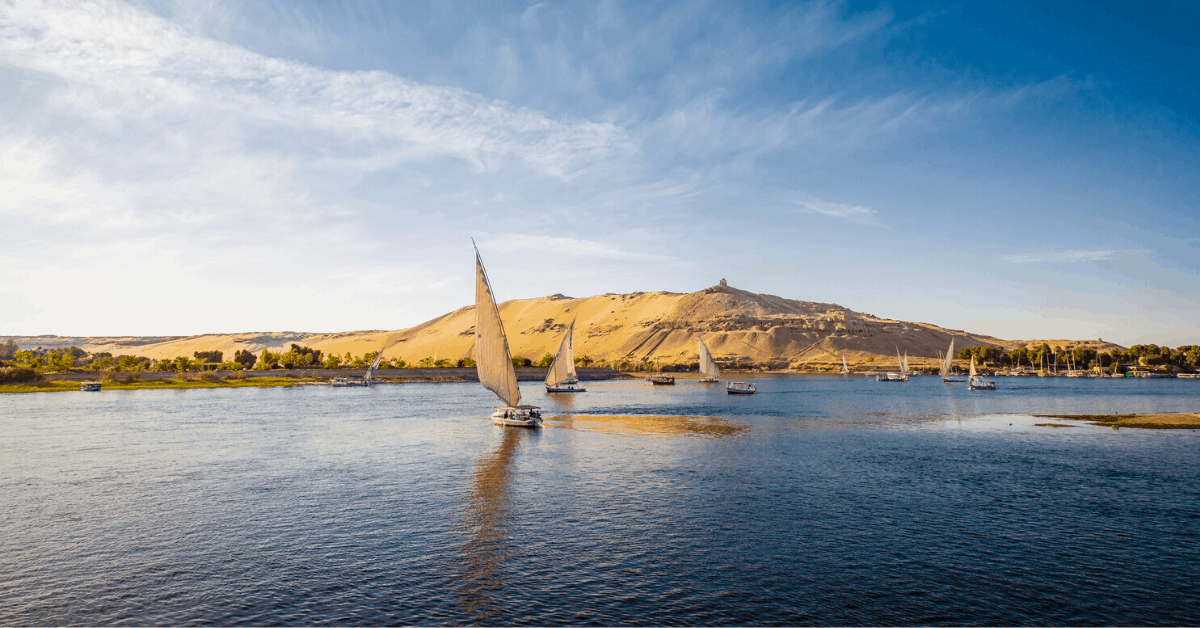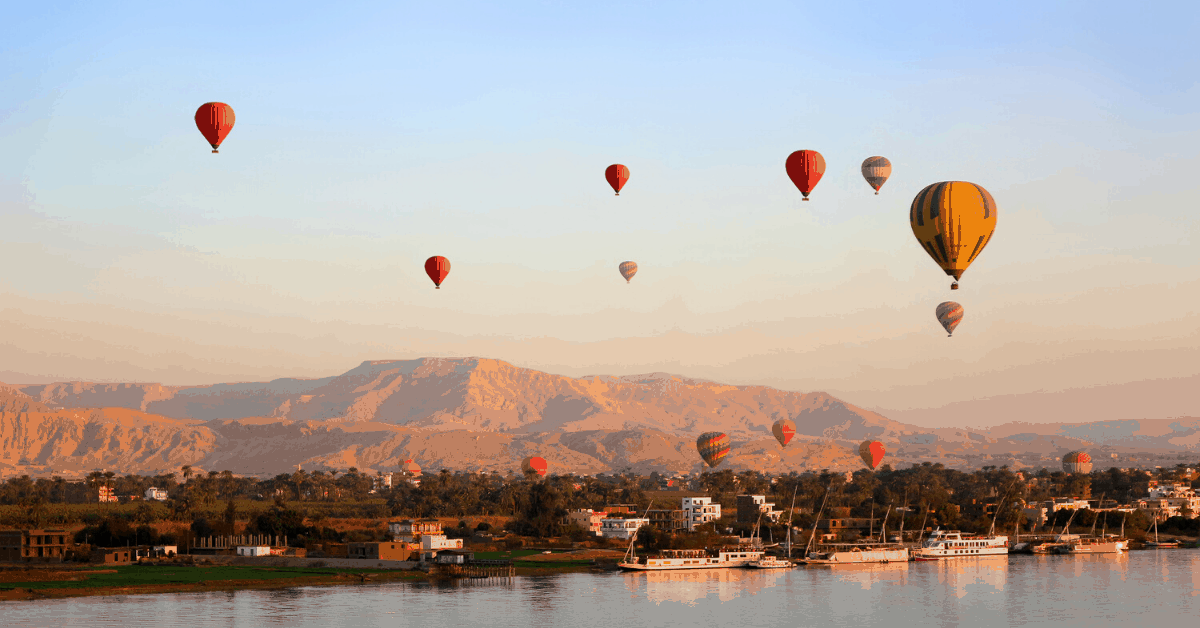Those eager to see the Nile for themselves can do so via water, from the shore, or even from the air.

More than two thousand years ago, Roman general Marc Antony and Queen of Egypt Cleopatra, were arguably the first to travel the Nile in style. They floated down the Nile in a gilded boat, a journey countless others have made over the years.
The Nile has been the constant life force of Egypt since ancient times. The river, 4,130 miles (6,650 kilometers) long, flows in a northerly direction from Sudan to the Mediterranean Sea.
The Nile made it possible for ancient Egyptians to settle and thrive and provided fertile land for crops such as wheat, flax, and papyrus.
Throughout the length of the Nile sits the remnants of Egypt’s ancient civilization, with much remaining largely unchanged.
In Cairo, the Sphinx and the Pyramids of Giza stand in the desert and further south in Luxor are many ancient sites. In Aswan, you can reach the Temples of Philae dedicated to Isis.
The Nile became, and remains, a prominent tourist destination largely as a result of Egyptomania. A term first coined in 1806, Egyptomania is the fascination with ancient Egypt and involves both exoticization and mythologization.
Egyptomania reached fever-pitch in the 1920s and 30s, sparked by British archaeologist Howard Carter’s discovery of Pharaoh Tutankhamun’s tomb in 1922. The find saw the well-to-do flocking to Egypt, with a journey down the Nile considered the pinnacle of any trip.
Those eager to see the Nile for themselves can do so via a variety of boats, from the shore, or even from the air.
Slow sailing in a dahabiya
Throughout the late 19th-century, travelers would float down the Nile in a dahabiya, a two-masted houseboat. Dahabiyas derive their name from the Arabic word for gold, “dhahab”, as the original boats were golden in color.
Journeys often begin in Aswan and end in or near Luxor, stopping at ancient sites along the way. These stops included Kom Ombo, a temple dedicated to Horus and Sobek, and the Temple of Horus at Edfu, built between 237 and 57 BC.
Traveling by dahabiya today has a few more mod cons onboard than in times past. Boats have up to 10 cabins and are luxuriously decked out with individual bathrooms, electricity, and Wi-Fi. Generally, dahabiyas have cooks and staff on-board and an Egyptologist as a guide.
English writer and Egyptologist Amelia Edwards wrote a bestselling travelogue in 1877, chronicling her experience traversing Egypt in a dahabiya.
Describing her first night aboard, she wrote, “The great mast towered up into the darkness. The river gleamed below. The stars shone overhead. We felt we were indeed strangers in a strange land.”
It’s possible to travel on the very boat Edwards sailed on. The Dongola has been restored and modernized and is part of Dahabiya Royal Cruise’s fleet. Other companies with stellar fleets include Nile Dahabiya Boats and Dahabiya.

Old style paddleboat glamour
Novelists Rudyard Kipling and Arthur Conan Doyle were both avid Nile paddle boat travelers.
There’s one standout paddleboat still in operation today called the Steam Ship Sudan, which author Agatha Christie famously traveled on in 1933. The boat also inspired the setting of her 1937 novel “Death on the Nile”.
While there are five beautiful suites and 18 cabins across two decks aboard the Steam Ship Sudan, the Agatha Christie Suite is the standout. On the starboard side of the prow, the suite offers breathtaking views of the Nile from large bay windows.
Stay bank side at the Old Cataract Hotel in Aswan
The town of Aswan is where you will find the Nile of childhood storybooks. The white sails of felucca boats sway in the breeze on the river, Nubian villages dot the landscape, banks are lush and green, and mountains can be seen in the distance. Staying in Aswan will feel as though you’ve stepped back in time.
In Aswan, there is no finer place to stay than the Old Cataract Hotel, where former guests include Winston Churchill and Princess Diana.
The opulent hotel sits on a cliff of pink granite and offers impressive views of the Nile. Famous for its high tea, it prides itself on retaining the charm of yesteryear with its Victorian colonial splendor.
Take to the skies in a hot air balloon at Luxor

Luxor, or ancient Thebes, offers a dizzying array of ancient sites. On the west bank, you can find the Theban Necropolis, an extensive area used for ritual burials, particularly during the Pharaonic period.
Here, you’ll find the Valley of the Kings and Queens, many mortuary temples, including the spectacular Mortuary temple of Hatshepsut, and tombs such as those for the Nobles and Artisans.
There’s no better way to see the area than from a hot air balloon at sunrise. Rides begin early so visitors can see the temples of the necropolis change color as the sun ascends the sky.
From above, guests can see the ancient mountain landscape, dotted with temples and ruins, flanked by green fields and the Nile. In the distance, on the east bank, you can see Karnak Temple and Luxor Temple. To book your own sunrise hot air balloon ride, check out Sinbad Balloons or Magic Horizon Balloons Luxor.
The romance with Egypt continues and travelers visit as a pilgrimage to the past, motivated by a desire to experience ancient Egypt. Traveling the Nile today is as breathtaking as ever and continues to blur the line between past and present.



